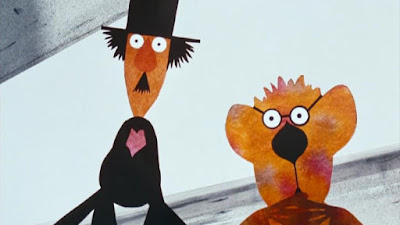Patch Town (2014) In
this imaginative low budget fantasy from director/co-writer Craig Goodwill
(based on his short film from 2011), people born from cabbages are transformed
into dolls (due to probably copyright infringement, Cabbage Patch Kids are
never expressly mentioned, but the comparison is unmistakable). When their
owners tire of them, they go back to their factory of origin, where the dolls
are transformed back into people, as laborers for an oppressive, totalitarian
corporation, led by Yuri (Julian Richings). Jon (Rob Ramsay) remembers his past
as a little girl’s doll, plotting his escape in a quest to find her again. He’s
joined by Sly (Suresh John), his wife Mary (Stephanie Pitsiladis), and their
adopted baby daughter. Goodwill blends fairy tale elements, music, and dystopian
themes to create a one-of-a-kind experience. I’m not sure who’s the intended
audience, but I admired the effort to make something that’s obviously not by
committee.
Rating: 3 ½ stars. Available on DVD and Amazon Prime
Big Bad Mama (1974)
Angie Dickinson stars in this Roger Corman-produced/Steve Carver-directed Depression-era
action/comedy as Wilma McClatchie. Along with her two daughters, she embarks on
a crime spree from East Texas (which looks suspiciously like Southern
California) to Southern California. She’s joined by bank robber Fred Diller (Tom
Skerritt) and William J. Baxter (William Shatner), an oily con man (Shatner reminds
us of two things he should never attempt: Southern accents or sex scenes). It’s
a good-natured drive-in fare that never takes itself too seriously. Filled with
ample amounts of sex, action and comedy, Big
Bad Mama delivers on its modest aims. Since it’s a Corman production, watch
for some of his regulars, including Dick Miller and Paul Bartel.
Rating: 3 stars. Available on Blu-ray, DVD and Amazon Prime
Into the Night (1985)
John Landis’ comedy/intrigue hybrid is short on laughs or thrills, but it has
its moments. Jeff Goldblum plays Ed Okin, an aerospace engineer with insomnia
and an existential crisis. He goes on a late-night drive to get away from his cheating
wife, and crosses paths with Diana (Michelle Pfeiffer), a young woman with a
shady past. In true femme fatale fashion, she’s on the run, with stolen emeralds
in tow. Ed unwisely chooses to help her out, and becomes entangled with the
same people who aim to kill her (including a ruthless killer, played by David
Bowie). Into the Night’s greatest
claim to fame is the amazing number of cameos (Landis must have phoned everyone
he knew in the business), including famous directors and industry professionals
(Roger Vadim, Rick Baker and Jim Henson – the list goes on). Unfortunately, the
numerous appearances only serve to reveal the film’s biggest weakness; the material
is stretched too thin, without enough story to sustain momentum over its nearly
two-hour runtime. Between the cameos and the continuous gallery of memorable
L.A. locations, there’s enough to keep the viewer somewhat occupied, but given
the assembly of talent, it could have been so much better.
Rating: 3 stars. Available on DVD
Liquid Sky (1982) Tiny
invisible aliens in a tiny flying saucer arrive in New York City, and set up base
on top of a penthouse apartment. They watch over Margaret, played by Ann
Carlisle, who appears in a second role as Jimmy, a junkie fashion model. There’s
also a German scientist (Otto von Wernherr) tracking the aliens, who reminded
me vaguely of Werner Herzog. Meanwhile, anyone who attempts to have sex with Margaret
dies, courtesy of the aliens that feed off endogenous opiates in her brain. The
film is a brightly colored, incoherent, plotless mess. It seems to be saying
something about the New York art scene, but what it is, I have no idea.
Rating: 2 ½ stars. Available on Blu-ray, DVD and Amazon
Prime

















